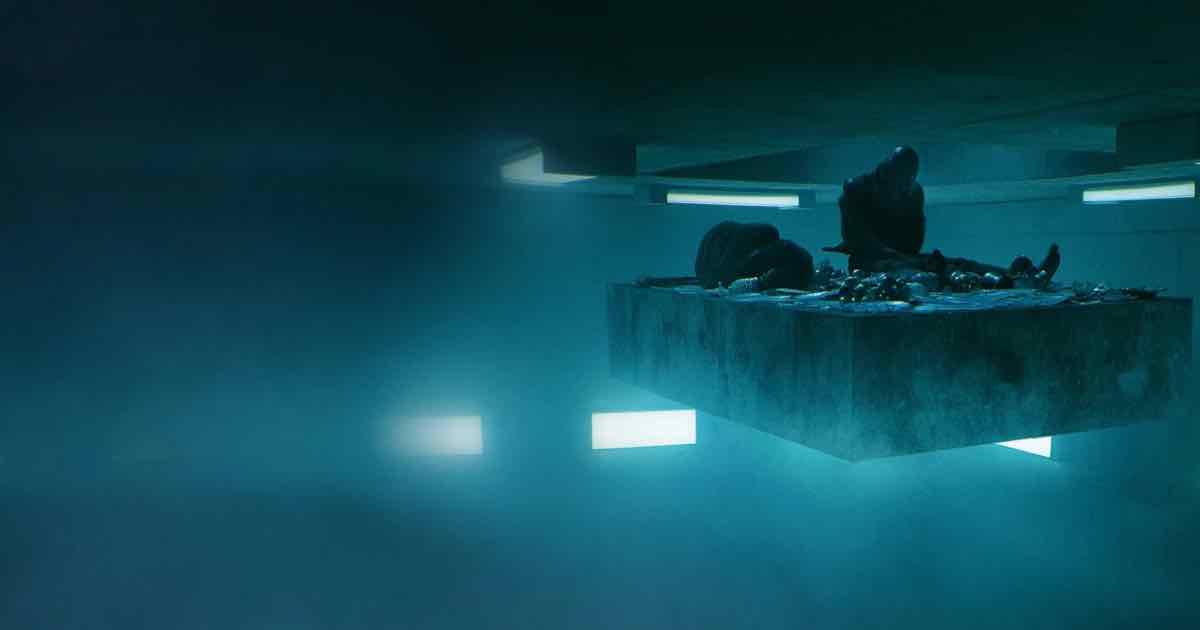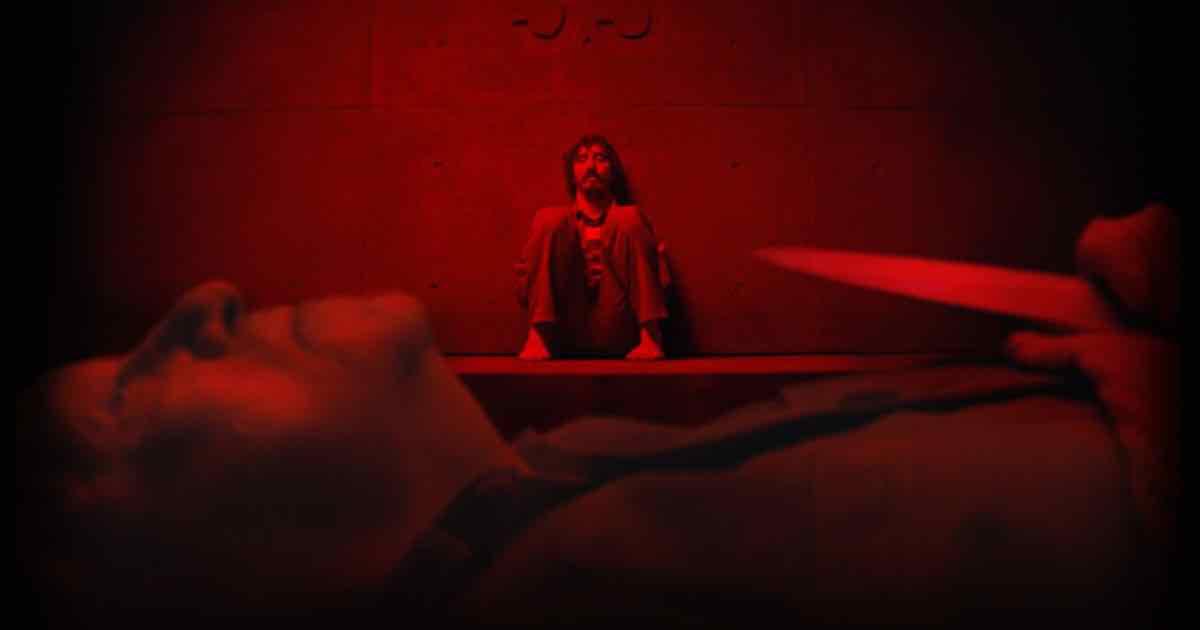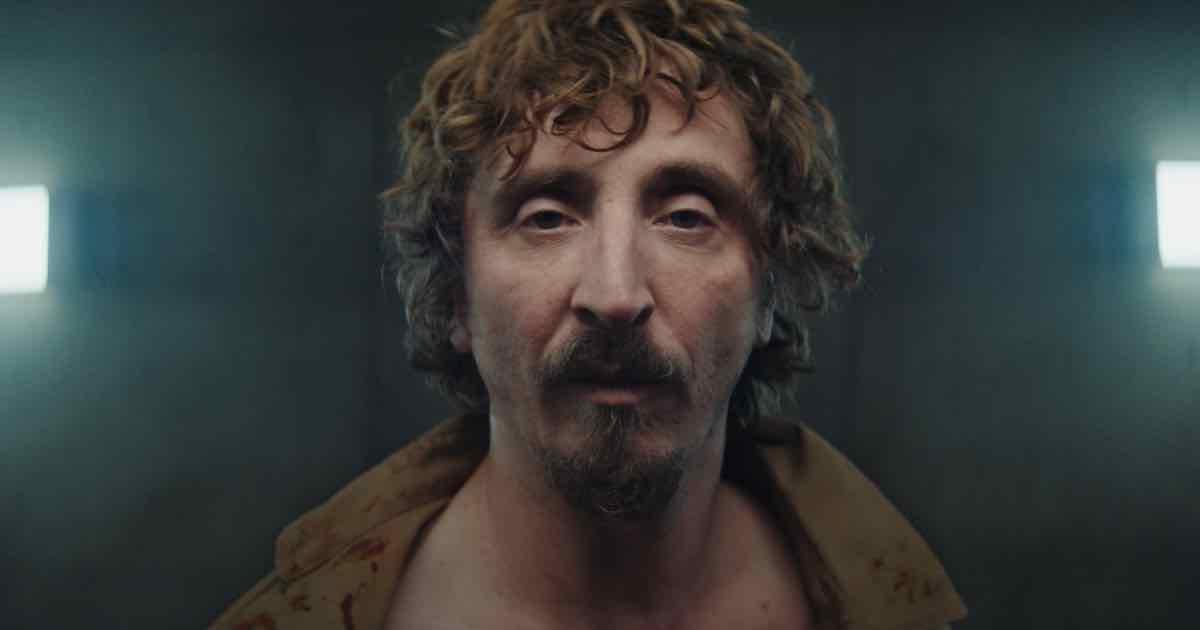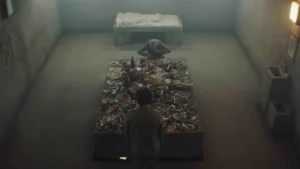Galder Gaztelu-Urrutia’s The Platform aka El Hoyo is a 2019 Spanish psychological horror-thriller. It’s mostly confined to a single dystopian setting that meticulously puts together a brutal social experiment. The film is based on the story by David Desola. Desola first had an idea to turn the story into a theatrical play. But when that didn’t work out, he joined forces with his friend and co-writer Pedro Rivero to turn the story into a script. Since it was a spec script, Desola and Rivero gradually worked on it and developed it over four years.
The story offers a thought-provoking examination of greed, punishment, human condition, and the nature of social hierarchies. The screenplay has the familiar three-act structure with some interesting allegories and quasi-religious undertones. Much of The Platform relies on expository dialogues, and therefore it’s not a very complicated film to grasp. At the same time, Platform isn’t a simple good-wins-over-evil story. It features potent metaphors, especially during its surprisingly ambiguous climax, that it’d be a gratifying experience to study its themes and symbolisms.
Let’s try to make sense of this human-made hell. Be warned: spoilers ahead!
The Dystopian Nightmare

The narrative is set largely inside a vertical prison-like facility, just addressed as ‘The Hole’. Each rectangle-sized floor has two occupants and there’s a big hole at the centre of the floor. A moving platform containing a lavish feast descends from one floor to another. The occupants of a floor have a few minutes to gorge on the food before the platform moves down. There are plenty of floors and so looking through the hole into the abyss can make one dizzy. We also don’t know exactly how many floors there are until the ending.
Moreover, there’s a vital rule. Each occupant can have the food only when the platform stays at their floor. They can’t save anything for later. Disobeying the rule might lead to them frying or freezing to death inside the cell. Of course, one can think that those at the top will have their fill, and those at the bottom will simply starve to death. Now here’s the catch: the occupants are assigned a new floor each month.
By randomly rearranging the people’s position within the hole, the institution simply addressed as ‘The Administration,’ crushes any idea of solidarity. Occupants assigned to top levels can become companions after gorging on the feast for a month. But when the chips are down, people either kill themselves or resort to cannibalistic savagery in order to sustain themselves at the lower levels.
Goreng wakes up in the Dystopian Pit
The Hole is a prison-like facility, but not exactly a prison. The movie’s protagonist Goreng (Ivan Massague) voluntarily enters into the premise after going through a bureaucratic process and signing documents. His intent is to obtain a diploma in exchange for spending six months in The Hole. On the outset, Goreng’s motivation might seem flimsy. But we don’t know what kind of near-future dystopian setting is out there. And maybe this diploma in some way is crucial to Goreng to find a livelihood.
But before entering into the hole via Goreng’s perspective, we see a group of chefs busily working to prepare a sumptuous banquet. An old man wearing a suit supervises everything. Soon, we learn that the banquet table is the platform at level 0. Do the people working in the kitchen know what happens below? Do the people working for The Administration understand the inhumanity of this social experiment? Many more questions arise in our mind while thinking about this facility, answers for some of them are hinted at while others are left ambiguous.
The sedated hero, Goreng slowly wakes up to find himself at level 48. His floor-mate is an old man named Trimagasi (Zorian Eguileor), who has spent a few months in The Hole. If Goreng represents the viewer’s blank state, Trimagasi is the person who helps us understand the complex rules that need to be followed in order to survive the place. There’s a nefarious tone in the way Trimagasi speaks. He is in there for accidentally killing a man. He was last assigned to level 132, where the platform most probably doesn’t reach with food. And now Trimagasi has a new floor-mate. It’s not hard to put together how the old man survived a month at a lower level.
Goreng’s first idea after understanding The Hole’s mechanics is to ration the food. He requests the level lower to him to do the same and pass on that message. But Trimagasi urinates on the food before reaching level 49, and destroys an attempt for solidarity. Trimagasi is of the idea that you should only look out for yourselves here. ‘Enjoy yourselves when assigned to a higher level and go to the extremes when confined to the bottom levels’, is Trimagasi’s motto. In fact, that’s the idea the faceless Administration wants to reinforce on the inmates.
The Mysterious Woman and Carnage at 171

Each occupants of The Hole is given a chance to bring an object of their liking. Apart from gaining a diploma, Goreng wants to get rid of his smoking habit and read Miguel de Cervantes’ epic novel Don Quixote. He assumes six months is enough to do both. The idea of bringing a book to The Hole and the thought of rationing food tells a lot about Goreng as a person. The self-centred Trimagasi has chosen the object he thinks can give him a chance to survive: a knife. Nevertheless, after the initial mutual distrust between Trimagasi and Goreng, the two get along fine at level 48.
The only disruption to their routine is the visitations of Miharu through the platform. Miharu is a mentally disturbed woman who perpetually searches for her daughter. Each month Miharu wakes up in her floor, murders her floor-mate with the hope that she can be re-united with her daughter. She’s forever descending or falling. Miharu also cold-bloodedly kills anyone who crosses her path. At a later point, it is stated that Miharu was an aspiring actress and that she never had a daughter.
Soon, the month is about to end. As the gas on the floor slowly puts them to sleep, Trimagasi asks Goreng to pray that they be assigned to one of the higher levels. However, Goreng wakes up to find himself tied to the bed. The level is 171. Now Goreng is simply a meat for Trimagasi to survive the month. Of course the old man doesn’t want to kill him in one go, and leave the meat to rot.
Trimagasi says he will carefully carve out morsels of flesh from Goreng, and only feast on him when his hunger is beyond control. But just as Trimagasi is about to cut Goreng after a week, Miharu passes through level 171. She repays Goreng’s early gesture of kindness by killing Trimagasi. Miharu also feeds the old man’s flesh to keep him alive. Goreng survives the month consuming dead Trimagasi’s flesh. This in turn triggers deep feelings of guilt and unsettling hallucination
An Idealist to a Pragmatist

The following month Goreng wakes up to find himself at level 33. His new floor-mate is a cancer-afflicted woman named Imoguiri (Antonia San Juan), the very office-worker who conducted Goreng’s interview for The Hole. Like Goreng she’s also volunteered to be there. She doesn’t bring an object with her, but a live animal: a dog named Ramesses II.
One interesting side note: Ramesses II is the Egyptian Pharaoh who crafted one of the earliest surviving peace treaties to avert war. In other words, Imoguiri is an idealist, visiting the Hole with a peace offering. Moreover, she refers to The Hole as ‘Vertical Self-Management Centre’ (VSC). Imoguiri firmly believes in creating a ‘spontaneous sense of solidarity’ among the inmates. She tells Goreng that there are 200 levels, and if everyone ration their portions, then food can easily reach the bottommost levels.
Every day when the platform reaches their level, Imoguiri prepares two rationed plates of food for the level below her. She requests those at level 34 to do the same. Naturally, her pleas are ignored. Goreng contemplates his own naiveté at level 48, while looking at Imoguiri. Trimagasi has killed a person without any remorse and has done the same inside The Hole. But Goreng isn’t self-centred or apathetic like his former floor-mate. Therefore, instead of staying nonchalant, he forces the people immediately below him to be altruistic. How? He threatens to defecate on their food if they don’t follow Imoguiri’s plan and further pass on the same threat to levels below.
Goreng knows that he can’t expect any altruism from the levels above. At the same time, the man’s good intentions have now gained a slight authoritarian tone. Imoguiri’s plan does seem to work for a time. But she is devastated when the deranged Miharu brutally kills Ramesses II. Besides, the month is about to end. In his fourth month in The Hole, Goreng wakes up at level 202. Yes, Imoguiri has been lied to by The Administration. There are more than 200 levels. She has already hung herself, providing Goreng a chance to survive. He does feed on her pass to survive the painful month.
The Man With the Plan
Goreng’s next-to-last month inside The Hole comes up, and he is relieved to find himself at level 6. His third floor-mate is Baharat (Emilio Buale Coka), a strong black man with a rope who harbours a dream to escape. If the people at the five levels help him, Baharat can reach level 0. But Baharat’s plan is met with a nasty and hostile reaction from the people above. Understanding that Baharat is a man of faith and action, Goreng convinces the man to join him in his rebellion. Goreng’s idea is to embark on the platform, and use force and fear to ration the food while descending.
Goreng doesn’t want to hand out food until level 50, since all these 100 people might have had something to eat the day before. They beat and kill people, who don’t believe their threats. At one of the levels, a man in a wheelchair, whom Baharat refers to as ‘Wise Man’ (Eric Goode), asks the duo to send a message through a simple act of rebellion. He asks them to preserve the delicious Italian custard, known as ‘Panna Cotta’, and send it back untouched to The Administration. The wise man further adds that The Administration doesn’t have a conscience to care about their message of rebellion. But the people working at level 0 might be troubled by this act and understand the message.
As per the plan, Goreng and Baharat start handing out food from level 51. Goreng estimates that there might be 250 levels. But when the platform descends beyond that they bear witness to gruesome scenes. They even come across Miharu’s gory death at one level. While trying to save her, both the men get injured. The platform eventually halts at level 333. To their surprise, the heavily wounded Goreng and Baharat find a little child at the bottommost level. Is she really Miharu’s daughter? Or is their mind playing up games with them after witnessing all the savage things? The Panna Cotta is given to the starving kid, and the dying men decide that the child is the message. The platform rapidly ascends with the kid. Believing that he has done the right thing and has made a difference, Goreng awaits his death.
Themes
The Indomitable Nature of Social Hierarchies
The Platform opens with the words, as expressed by Trimagasi: “There are three types of person. Those at the top, those at the bottom, and those who fall.” We can interpret this line as representing the rich who are content with the status quo, the poor who desire change but are left voiceless & powerless, and those who voluntarily descend down – like Goreng and Baharat – to change the things. The Platform’s vertical structure is compared with the horizontal structure of a stratified post-apocalyptic train in Bong Joon-ho’s Snowpiercer (2013). While Snowpiercer is about the disgruntled poor fighting for dignity and more space, The Platform is about the food. Food is the most basic necessity for any living organism. Hence, the literal fight for it is perfectly employed to portray the grim inequalities in our hierarchy-based society.
On the outset, The Platform can come across as a familiar critique on the Capitalist structure. In whatever way the people inside The Hole work and scheme for their survival, the rules of the game repeatedly put them in a precarious position, and ask them to either do their worst or perish. We can read it as a critique on various mutations of capitalism like neoliberalism, gig-economy, etc. Naturally, the fair distribution of wealth and food sounds like the perfect plan to counter the inhumane financial models.
But that’s easier said than done. By believing that his intentions are pure and good, Goreng does impose his will on others. Both Goreng and Baharat fight and kill more people while descending to fairly distribute the food. In fact, they even beat up the same people whom they wanted to aid. Thus, the film makes it clear that political ideologies often fail people. The ideologies seek perfection from a race that’s very imperfect.
Punishment
While The Hole is not exactly a prison, the majority of people who are there have committed violent crimes. In general, we espouse that punishment is to rehabilitate individuals. But we know that prisons often reward the most violent. One can argue that it’s the same in the real world, where people, without any scruples, easily survive and proliferate, than the ones who believe in humanistic principles. However, in prison the basic criteria for survival is to literally fight for it. The facilities are designed to encourage carnage and savagery.
Though The Platform is set in a near-future dystopian setting, it sounds the alarm bell that our society’s idea of punishment can lead to brutal social-conditioning experiments. Furthermore, it emphasizes that it’s not punishment when the criminals of a society are left to literally or figuratively cannibalise upon themselves.
Hedonism, Altruism and Authoritarianism

Trimagasi and most of those caught in the unfair system lean towards hedonism. The hedonistic perspective allows Trimagasi to enjoy the pleasure of being at a higher level, and also strengthen his ideas about self-preservation at any cost. The latter is only perceived when Trimagasi is shifted to a foodless lower level. The lack of trust is part of a hedonistic view, and hence the old man believes he needs to restrain Goreng before Goreng does the same to him. While Trimagasi’s hedonism has benefitted him to that point, he eventually meets a grim fate.
On the other hand, there’s Goreng and Imoguiri. Both are idealists who believe altruism and solidarity can break the inhumane system. While their altruism does sound good enough, their pleas fall on deaf ears. Goreng’s outlook changes and he starts believing that even a good cause needs to be forced upon others. Imoguiri loves every living thing, and hence is unwilling to speak harshly or impose anything on others. In fact, her death by suicide isn’t an act of despair, but sacrifice. Goreng earlier cannibalised on Trimagasi, and now on Imoguiri. And when he wakes up at the sixth level, he sort of internalises the domineering tone of Trimagasi with the altruistic perspective of Imoguiri and implements a plan of action.
Trimagasi is seen as cruel and Imoguiri as weak due to their staunch beliefs. Subsequently, Goreng and Baharat adopt a dynamic sense of morality, where they beat the greedy to death and offer kindness to those who cooperate. Does this mix of benevolence and authoritarian behaviour help Goreng achieve what he wanted? Again, we aren’t given any easy answers. But Goreng’s internal journey is an act of nonconformity unlike Trimagasi’s and Imoguiri’s.
The Messiah
Goreng – the lanky bearded guy – is characterised as a Christ-like figure. He is referred to as a ‘saviour’ and ‘messiah’ by the inmates in a mocking tone. And he eventually makes a descent to his martyrdom. His final gesture is an act of kindness, and he enacts what he read in Don Quixote, “the wealthy man who is not generous will be a miserly beggar”.
There are theories that the child is the ‘messiah’, and Goreng is the ‘prophet’ who facilitates her ascent. The number 333 – the exact number of levels – is also rich with biblical themes. If the number of inmates in The Hole are 666 – the brand of hell and mark of the beast – then Goreng’s vertical journey is seen as a journey through hell towards his liberation.
Interestingly, one can also interpret level zero as heaven, the relentlessly busy head chef being the God who oversees the tasks of his angel-like chefs. There’s one wordless moment when the head chef obsessively investigates whose hair is in the dish that was just prepared. It goes to show how the head chef demands perfection in all that’s being created or made under his supervision. From a religious standpoint, it’s a way of saying that God’s design was flawless, but it’s us humans who make a mess of everything.
The Platform’s Deliberately Ambiguous Ending

The Platform’s ending was deliberately open-ended and leaves us with more questions than answers. When Goreng and Baharat first encounter the kid at level 333 the first question that comes to our mind is: Is this Miharu’s kid? The next question is: Did the Administration lie to Imoguiri about not confining anyone under 16? We know that The Administration has already lied to Imoguiri, since she believed that there are only 200 levels. So they probably lied about the kid and Miharu’s original identity.
We only assume that the kid must be Miharu’s. There’s also the question of how the kid looks unscathed and well-fed. Maybe Miharu fed her kid, and killed the kid’s floor-mate each month in order to avoid the cannibalization scenario. And what purpose does a kid serve in the Administration’s experiment?
There’s an eerie, alternate theory that says that there is no kid. The kid was Goreng and Baharat’s shared hallucination. Goreng spots the kid first after witnessing a gruesome death of the kid’s alleged mother a few levels above. The guilt of not saving the woman who once saved him could have led to Goreng’s vision of the kid. She represents purity, innocence that’s more valuable than ‘Panna Cotta’. Hence, the dying Goreng believes that a child is the message, and such a potent message doesn’t require a bearer.
There are flaws to this theory too. Baharat too sees the kid, and agrees to feed him with ‘Panna Cotta’. A shared psychotic disorder in the form of hallucination is a possibility, but it sounds a bit far-fetched and absolutely grim. It means that Goreng’s action will fade away into oblivion, and The Hole will continue its nasty experiment unabated. On the other hand, the final image of the kid’s rapid ascent withholds some hope as well as nullifies the theory of hallucination. The system might not be fixed, but the ideas of rebellion and non-conformity will always drive humans to try to change things.
The Platform was released as a Netflix original film in February 2020. It was the beginning of the Covid 19 pandemic. It was a pandemic that devastatingly exposed our lack of solidarity across class. The film’s release has eerily coincided with our own confinement in an atmosphere of fear and uncertainty. It holds a mirror to our society, and through suspense and drama tells us the two most important things for our race’s survival — empathy and solidarity.
